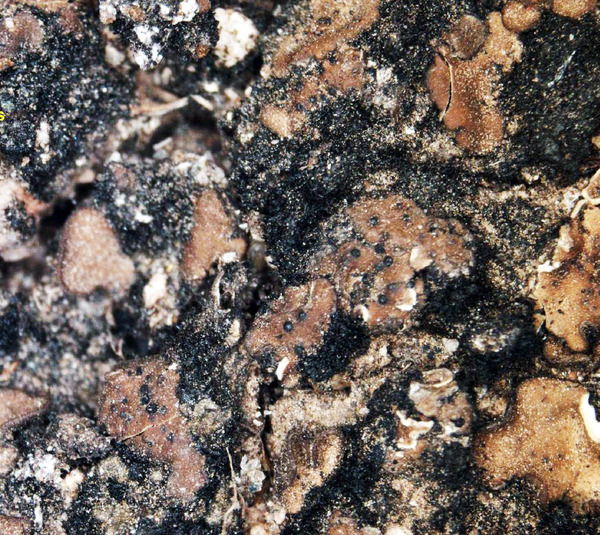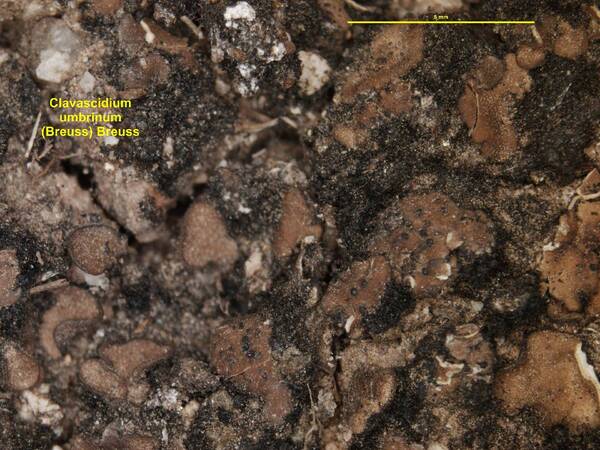Clavascidium umbrinum (Breuss) Breuss
Ann. naturhist. Mus. Wien, 98 (suppl.): 41, 1996. Basionym: Catapyrenium umbrinum Breuss - Linzer biol. Beitr., 22: 78, 1990.
Synonyms: Placidium umbrinum (Breuss) M. Prieto & Breuss
Distribution: N - Piem.
Description: Thallus squamulose, medium to dark brown, dull, epruinose. Squamules 2-4 mm broad, 0.2-0.3 mm thick, rounded or slightly lobed, flattened, smooth, dispersed or loosely aggregated, usually not overlapping, rather fragile. Lower surface pale to usually dark, attached by simple dark rhizines and by 4-5.5 µm thick, brown rhizohyphae. Upper cortex paraplectenchymatous, 20-50 µm thick; medulla white in upper part, brownish in lower part; lower cortex absent. Perithecia laminal, black, immersed in the squamules, broadly pyriform, without involucrellum, up to 0.4 mm across. Exciple black-brown throughout; hymenium colourless, the hymenial gel hemiamyloid; paraphyses absent, substituted by periphyses. Asci 8-spored, clavate, thin-walled, the wall I-, with biseriately arranged spores, 50–55 × 15–20 µm. Ascospores 1-celled, hyaline, thin-walled, 13-17 x 6-8 µm. Pycnidia black, marginal, immersed, Dermatocarpon-type. Conidia oblong-ellipsoid, 3-5 x c. 1-2 µm. Photobiont chlorococcoid. Spot tests: cortex and medulla K-, C-, KC-, P-, UV-. Chemistry: without lichen substances. Note: a terricolous lichen found on calciferous, clayey soil; only known from Dalmatia, France and Piemonte, this species is worthy of further study.
Growth form: Squamulose
Substrata: soil, terricolous mosses, and plant debris
Photobiont: green algae other than Trentepohlia
Reproductive strategy: mainly sexual
Commonnes-rarity: (info)
Alpine belt: absent
Subalpine belt: absent
Oromediterranean belt: absent
Montane belt: extremely rare
Submediterranean belt: extremely rare
Padanian area: absent
Humid submediterranean belt: absent
Humid mediterranean belt: absent
Dry mediterranean belt: absent

Predictive model
Growth form: Squamulose
Substrata: soil, terricolous mosses, and plant debris
Photobiont: green algae other than Trentepohlia
Reproductive strategy: mainly sexual
Commonnes-rarity: (info)
Alpine belt: absent
Subalpine belt: absent
Oromediterranean belt: absent
Montane belt: extremely rare
Submediterranean belt: extremely rare
Padanian area: absent
Humid submediterranean belt: absent
Humid mediterranean belt: absent
Dry mediterranean belt: absent

Predictive model
 INDEX FUNGORUM
INDEX FUNGORUM
 GBIF
GBIF



